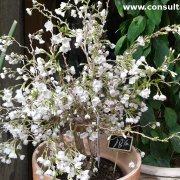Care of the shrub Prunus incisa or Fuji cherry |
|
The genus Prunus, family Rosaceae, comprises 200 species of trees and shrubs native to temperate regions of the Northern Hemisphere. Some species are: Prunus incisa, Prunus dulcis, Prunus cerasifera, Prunus avium, Prunus laurocerasus, Prunus domestica, Prunus mahaleb, Prunus lusitanica, Prunus spinosa, Prunus persica, Prunus armeniaca, Prunus serrulata, Prunus cerasus. Common name: Fuji cherry. This species is native to Japan. They are deciduous shrubs of compact size that reach 2 meters (6.56 feet) in height. The leaves are small and light green; they take on beautiful orange and red tones in autumn. The abundant, bright flowers are first pink and then white. They bloom from late winter to early spring. Fuji cherry is used in large pots for patios and terraces, in rockeries and as isolated specimens in small and medium gardens. Prunus incisa prefers full sun exposure in cool summer regions but in Mediterranean climates it prefers light shade. It resists frost down to -15 ºC (5 ºF). The soil can be a garden substrate with 15% coarse sand and 15% organic matter. Water regularly without flooding, waiting for the substrate surface to dry. In winter, water considerably less. Fertilize with compost or manure in the fall. Prunus incisa resists intense pruning to maintain a compact appearance. Fuji cherry can be attacked by leaf miners, caterpillars or by fungi in case of excessive watering. Prunus incisa is propagated by semi-woody cuttings in summer. |
Images of the shrub Prunus incisa or Fuji cherry |
Find plants
Prunus incisa or Fuji cherry | Care and Growing
© 2026 FavThemes


